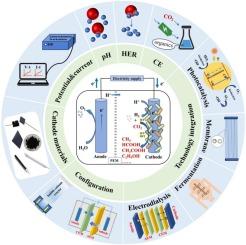微生物电合成CO 2到多种碳产物:代谢途径,关键因素和可持续发展前景
IF 7.7
2区 工程技术
Q1 CHEMISTRY, APPLIED
引用次数: 0
摘要
近年来,减少CO₂排放,实现CO₂资源化利用已成为全球共识。但是,目前的CO₂减少技术存在能源投入高、运营费用高、二次污染风险大等问题。微生物电合成(MES)将微生物在电极上的代谢活动与电能结合起来,将CO₂转化为有机物。MES虽然具有反应条件温和、运行成本低、高附加值产品潜力等优点,但仍存在电子传递效率低、转化率低、反应器设计和操作不当等障碍。因此,本文对具有CO2转化的MES进行了全面的综述,旨在找出这一过程的决定因素并探索其未来的研究方向。本文主要有三个方面的工作:首先,详细介绍了MES的典型脂肪酸和酒精产量(3.5 ~ 5700 mg L−1 d−1)及其代谢途径。其次,对反应器结构、电极材料、阴极电位(一般为−0.8 ~−1.2 V vs. Ag/AgCl)和库仑效率(17.6% ~ 113.6%)等影响MES性能的因素进行了综合讨论。最后,讨论了微生物电化学还原CO₂面临的挑战,并提出了未来的研究方向。本文章由计算机程序翻译,如有差异,请以英文原文为准。

Microbial electrosynthesis of CO₂ to multiple carbon products: Metabolic pathways, key factors, and sustainable prospects
In recent years, CO₂ emission has been a global consensus that it is urgent to reduce CO₂ emissions and realize CO₂ resource utilization. However, current technologies for CO₂ reduction have the problems of high energy input, high operational costs, and a risk of secondary pollution. Microbial electrosynthesis (MES) combines the metabolic activities of microorganisms on electrodes with electrical energy to convert CO₂ into organics. Although MES has the advantages of mild reaction conditions, low operational cost, and potential for high-value-added products, it still confronts obstacles like low electron transfer efficiency, low conversion rate, improper reactor design and operation, etc. Therefore, this paper provided a comprehensive review of MES with CO2 conversion, aiming to identify the determinants of the process and exploit its future research directions. There are three tasks in this review: Firstly, typical fatty acid and alcohol production (3.5 to 5700 mg L−1 d−1) from MES and their metabolic pathways were introduced elaborately. Secondly, the determining factors of MES, such as reactor configuration, electrode material, cathodic potential (generally −0.8 to −1.2 V vs. Ag/AgCl), and coulombic efficiency (17.6 % to 113.6 %), were comprehensively discussed. Finally, challenges of microbial electrochemical reduction of CO₂ were discussed, and future research directions were proposed.
求助全文
通过发布文献求助,成功后即可免费获取论文全文。
去求助
来源期刊

Fuel Processing Technology
工程技术-工程:化工
CiteScore
13.20
自引率
9.30%
发文量
398
审稿时长
26 days
期刊介绍:
Fuel Processing Technology (FPT) deals with the scientific and technological aspects of converting fossil and renewable resources to clean fuels, value-added chemicals, fuel-related advanced carbon materials and by-products. In addition to the traditional non-nuclear fossil fuels, biomass and wastes, papers on the integration of renewables such as solar and wind energy and energy storage into the fuel processing processes, as well as papers on the production and conversion of non-carbon-containing fuels such as hydrogen and ammonia, are also welcome. While chemical conversion is emphasized, papers on advanced physical conversion processes are also considered for publication in FPT. Papers on the fundamental aspects of fuel structure and properties will also be considered.
 求助内容:
求助内容: 应助结果提醒方式:
应助结果提醒方式:


